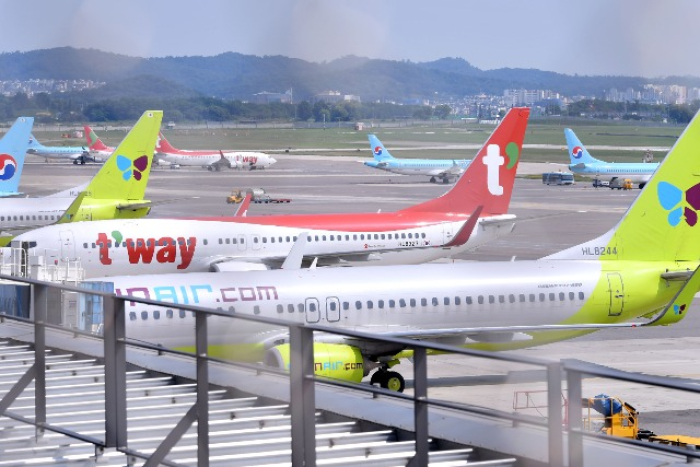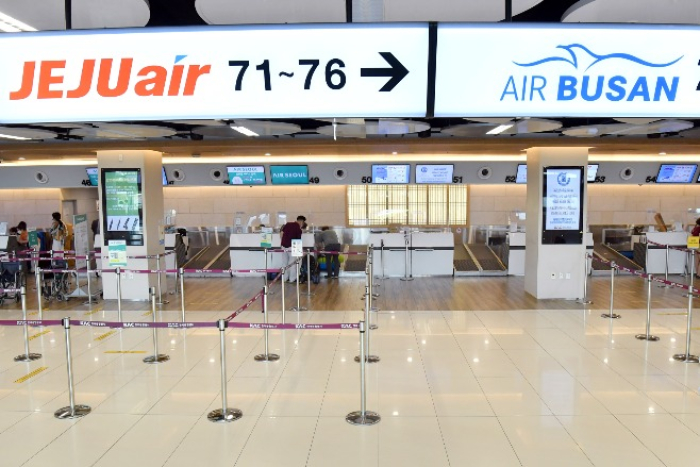
South Korea’s low-cost carriers (LCCs) are racking up losses as slowing growth in travel particularly to Japan fueled price wars to fill excess seats following aggressive fleet expansion and route additions last year.
The deadly crash of a Jeju Air flight from Bangkok at Muan International Airport in December accelerated a passenger shift toward full-service carriers, dealing another blow to LCCs.
According to Hankyung Aicel, the alternative data platform of The Korea Economic Daily, credit card transactions by passengers of the country’s top four budget carriers – Jeju Air Co., Jin Air Co., T’way Air Co. and Air Busan Co. – fell 26% to a total of 490.1 billion won ($352 million) in the second quarter of this year.
The figures are based on credit card spending by their passengers across online and offline platforms, compared with the year-earlier period.

Passenger traffic on routes from South Korea to Japan, which account for 50% of Korean LCCs’ flights, grew 5.4% to 2.39 million in May, compared with a 34.8% surge in the same period of last year, according to Korea Tourism Organization.
Amid fierce competition, some domestic LCCs has offered one-way flights between Japan and Jeju Island for as low as below 10,000 ($7). Jeju Island is South Korea’s largest island, located in the south.
Overall, the number of outbound passengers from South Korea has risen by 2-7% on-year since the start of this year, a steep fall from the 55.5% spike in January 2024 during the peak of the post-pandemic overseas travel growth.

KOREAN AIR FARES WELL
Despite the softening travel demand, Korean Air Lines Co. remained resilient.
Passengers’ credit card transactions with the country’s flagship carrier edged up 0.2% on-year to 454.4 billion won in the second quarter, according to Hankyung Aicel.
“The slight uptick in outbound travelers was concentrated on low-cost, short- and medium-haul international routes,” said an aviation industry official. “However, since the fatal accident at Muan International Airport last December, demand has been steadily shifting to full-service carriers, intensifying price competition among LCCs.”
Jeju Air, the country’s largest LCC with a fleet of 43 aircraft, saw a 26% drop on-year to 138.5 billion won in credit card transactions by passengers in the second quarter.
“Jeju Air cut fares by 9% in the first quarter, the peak season (for Japan), to defend its market share,” said Choi Go-eun, an analyst at Korea Investment & Securities. “It may take more than one year for the airline to recover from the fallout of the Muan airport accident.”
The carrier is projected to report a 47.0 billion won loss in the second quarter, nearly five times larger than the shortfall recorded in the same period last year, according to market consensus.
Hankyung Aicel tracks credit card spending by 20 million card holders on a weekly basis.
Due to the diverse sales channels for airline tickets, the estimated figures tend to fall short of actual airline revenue. However, they show an average correlation of 90% with actual sales.

Passengers’ credit card spending with Jin Air, which operates a fleet of 31 planes, shrank to 29% to 134.7 billion won.
T’way Air suffered a 16% fall to 142.6 billion won in credit card settlement by passengers. It is forecast to have extended losses for a fifth quarter in a row in the second quarter, despite a drop in fuel costs and the stronger won currency
CHINA ROUTES
To rebound from the slump, Korean airlines are ramping up flights to China on expectations that Beijing would grant South Korean citizens visa-free entry for group tourists.
South Korea’s tourism sector saw a sharp increase in Korean travelers to China following China’s introduction of a visa-free policy for short-stay travelers for a period from November 8, 2024, to December 31, 2025.
The country’s air travelers to China increased on-year by 54.8% to 1.65 million since November last year to May this year.

Incoming tourists from China are also expected to rebound amid the global popularity of Korean content.
In December, the Ministry of Culture, Sports and Tourism said it was strongly considering visa exemptions for Chinese group tourists organized by dedicated Korea-China travel agencies.
“Sales at LCCs are expected to bottom out as South Korea and China are expected to expand mutual visa-free travel,” said a Korean airline official.
By Tae-Ho Lee and Jae-Kwang Ahn
thlee@hankyung.com
Yeonhee Kim edited this article.














